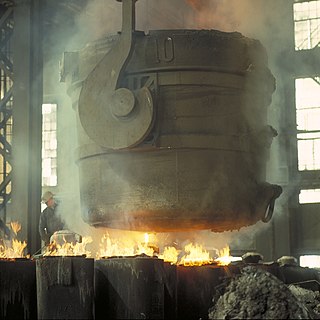See also
- Biosteel, a silk-based material produced by AMSilk
BioSteel may refer to:

A forge is a type of hearth used for heating metals, or the workplace (smithy) where such a hearth is located. The forge is used by the smith to heat a piece of metal to a temperature at which it becomes easier to shape by forging, or to the point at which work hardening no longer occurs. The metal is transported to and from the forge using tongs, which are also used to hold the workpiece on the smithy's anvil while the smith works it with a hammer. Sometimes, such as when hardening steel or cooling the work so that it may be handled with bare hands, the workpiece is transported to the slack tub, which rapidly cools the workpiece in a large body of water. However, depending on the metal type, it may require an oil quench or a salt brine instead; many metals require more than plain water hardening. The slack tub also provides water to control the fire in the forge.

Galvanization or galvanizing is the process of applying a protective zinc coating to steel or iron, to prevent rusting. The most common method is hot-dip galvanizing, in which the parts are submerged in a bath of hot, molten zinc.

The interdisciplinary field of materials science covers the design and discovery of new materials, particularly solids. The field is also commonly termed materials science and engineering emphasizing engineering aspects of building useful items, and materials physics, which emphasizes the use of physics to describe material properties. The intellectual origins of materials science stem from the Age of Enlightenment, when researchers began to use analytical thinking from chemistry, physics, and engineering to understand ancient, phenomenological observations in metallurgy and mineralogy. Materials science still incorporates elements of physics, chemistry, and engineering. As such, the field was long considered by academic institutions as a sub-field of these related fields. Beginning in the 1940s, materials science began to be more widely recognized as a specific and distinct field of science and engineering, and major technical universities around the world created dedicated schools for its study.

Steel is an alloy made up of iron with typically a few tenths of a percent of carbon to improve its strength and fracture resistance compared to other forms of iron. Many other elements may be present or added. Stainless steels that are corrosion- and oxidation-resistant typically need an additional 11% chromium. Because of its high tensile strength and low cost, steel is used in buildings, infrastructure, tools, ships, trains, cars, machines, electrical appliances, weapons, and rockets. Iron is the base metal of steel. Depending on the temperature, it can take two crystalline forms : body-centred cubic and face-centred cubic. The interaction of the allotropes of iron with the alloying elements, primarily carbon, gives steel and cast iron their range of unique properties.

Stainless steel is an alloy of iron that is resistant to rusting and corrosion. It contains at least 11% chromium and may contain elements such as carbon, other nonmetals and metals to obtain other desired properties. Stainless steel's resistance to corrosion results from the chromium, which forms a passive film that can protect the material and self-heal in the presence of oxygen.

Flint is a sedimentary cryptocrystalline form of the mineral quartz, categorized as the variety of chert that occurs in chalk or marly limestone. Flint was widely used historically to make stone tools and start fires.

Pig iron, also known as crude iron, is an intermediate product of the iron industry in the production of steel which is obtained by smelting iron ore in a blast furnace. Pig iron has a very high carbon content, typically 3.8–4.7%, along with silica and other constituents of dross, which makes it very brittle and not useful directly as a material except for limited applications.

Reinforced concrete (RC), also called reinforced cement concrete (RCC) and ferroconcrete, is a composite material in which concrete's relatively low tensile strength and ductility are compensated for by the inclusion of reinforcement having higher tensile strength or ductility. The reinforcement is usually, though not necessarily, steel bars (rebar) and is usually embedded passively in the concrete before the concrete sets. However, post-tensioning is also employed as a technique to reinforce the concrete. In terms of volume used annually, it is one of the most common engineering materials. In corrosion engineering terms, when designed correctly, the alkalinity of the concrete protects the steel rebar from corrosion.

The Brinell scale characterizes the indentation hardness of materials through the scale of penetration of an indenter, loaded on a material test-piece. It is one of several definitions of hardness in materials science.

Carbon steel is a steel with carbon content from about 0.05 up to 2.1 percent by weight. The definition of carbon steel from the American Iron and Steel Institute (AISI) states:
Jack Raphael Ham Jr. is an American former professional football player who was an outside linebacker for the Pittsburgh Steelers of the National Football League (NFL) from 1971 to 1982. He is considered one of the greatest outside linebackers in the history of the NFL. Ham was inducted into the Pro Football Hall of Fame in 1988 and the College Football Hall of Fame in 1990. In mid-2019 the newsletter of the PSU Alumni Association rated Ham first among the 100 greatest athletes, considering all sports and all previous football players, in University history.

Christopher Grey Ruegamer [ROO-gah-mer] is a former American football center. He played college football at Arizona State and was drafted by the Miami Dolphins in the third round of the 1999 NFL Draft.
A spiritual successor is a product or fictional work which is similar to, or directly inspired by, another previous work, but does not explicitly continue the product line or media franchise of its predecessor, and is thus only a successor "in spirit". Spiritual successors often have similar themes and styles to their source material, but are generally a distinct intellectual property.

Char cloth, also called char paper, is a material with low ignition temperature, used as tinder when lighting a fire. It is the main component in a tinderbox. It is a small swatch of fabric made from a natural fibre that has been converted through pyrolysis.
Roddis Franklin "Pete" Drake, was a Nashville-based American record producer and pedal steel guitar player. One of the most sought-after backup musicians of the 1960s, Drake played on such hits as Lynn Anderson's "Rose Garden", Charlie Rich's "Behind Closed Doors", Bob Dylan's "Lay Lady Lay", and Tammy Wynette's "Stand by Your Man". Drake was inducted into the Country Music Hall of Fame in 2022, 33 years after his death.
Naval Materials Research Laboratory (NMRL) is an Indian defence laboratory of the Defence Research and Development Organisation (DRDO). Located at Ambernath, in Thane district, Maharashtra. It develops materials and alloys for Naval use, and is a single-window agency for all materials requirement of the Indian Navy. NMRL is organized under the Naval Research & Development Directorate of DRDO. The present director of NMRL is Shri Prashant T Rojatkar.

Roy Lewis, Jr. is a former American football cornerback. He was signed by the Pittsburgh Steelers as an undrafted free agent in 2008. He played college football at Washington. With the Steelers, he won Super Bowl XLIII against the Arizona Cardinals. He is now a firefighter for the City of Phoenix in Arizona.

Mishra Dhatu Nigam Limited, is a specialized metals and metal alloys manufacturing facility in India, located in Hyderabad, Telangana. It is a Public Sector Undertaking (PSU), under the administrative control of Department of Defence Production, Ministry of Defence, Government of India. MIDHANI is the only producer of Titanium in India.
The Pittsburgh Steelers All-Time Team was named as a part of the franchise's 75th season celebration in 2007. The club's top 33 players were selected in commemoration of the franchise's founding in 1933. The team was chosen on the basis of fan voting.
Defence Materials and Stores Research and Development Establishment (DMSRDE) is a laboratory of the Indian Defence Research and Development Organisation (DRDO) at Kanpur. It is responsible for the research and development of materials for the Indian military services, including various types of protective clothing and equipment.